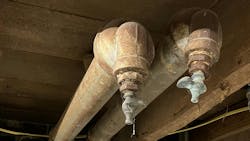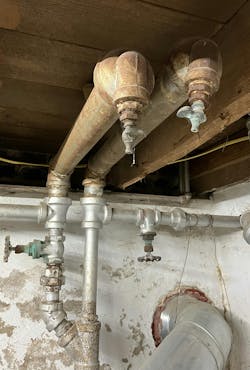This installation predates the 1960s hot water jobs I’ve been talking about lately. This one is mid-century modern from the 1950s. The modern part of it was all the diversion tees installed. You don’t see them in the photo, but they were everywhere in the distribution piping. The fact that there were so many is what dates it from the early post war period.
Diversion tees were developed to divert a portion of the hot water from the main through the radiation and back to the main. The tee was designed to create a big enough pressure drop along the run of the tee to create the flow on the branch, without creating too much pressure drop in the main. It was a delicate balance.
Bigger is Better
Like anything of that era, bigger or more was better. The installing contractor on this job decided that if one diversion tee per radiator was okay, then I’m going to install two. When I went to a school in Chicago in the 1980s, the textbooks indicated that one diversion tee per radiator was typical.
This leads us to the photo and the large pipes at the end of each main. As you can see by the tees that they’re connected too, they’re actually larger than the size of the mains. If you take off those reducing elbows at the end, they remind me of big dual exhaust pipes on a hot rod, or the modified BMW 330 that my son used to own.
What Were They Thinking?
I’ve been spending a lot of time trying to figure out what this installer was thinking, since I have never seen this before in person or in print. I have to believe that it had something to do with air control. The little ¼”air cocks at the end were probably installed to vent air, since I can’t think of a reason to drain water through the tiny port.
In the photo, one of the mains comes from the right while the other main comes from the left, to combine in the throw-back wye tee to have a single return to the boiler. Before they get to the wye tee, each has an old school non-rising stem gate valve. Nowadays, we use the all-purpose ball valve in this situation.
If either of those valves is closed, it acts to isolate any flow from the return line to get to the little cocks at the end of those huge pipes. With the valve now closed and the cock open, any fresh water coming into the system has to pass along the main, through all those diversion tees and out the air cock, pushing any air out. So it looks like this set up might be for purging the air from the system.
However, the idea of purging air from a loop only works if the loop doesn’t have any branches. I see the purge correctly installed mostly in apartment buildings with a loop of radiation per apartment. The beauty of this set-up, if installed in the basement, is not having to go into any apartments to clear an air lock. Not having to find the super, moving any furniture, or taking abuse from disgruntled tenants.
In this system, each of those two loops has about eight radiators connected to it. So, if you use the installed valves in the photo, the air gets purged out of the main only, which isn’t much help, since the air is still present in the radiators. The diversion tees work to create circulation through the radiators, but not to purge air.
A Mystery – And a Lucky Break
So maybe the size of the pipes has something to do with it. Why else make them so large? There were air chambers that used to be sold that you could use to accumulate air before manual air vents. Maybe the installer was thinking that the huge pipes would accumulate air? Maybe he used the large pipes in place of an expansion tank? Anyway, this is one mystery that I may never solve—your thoughts are welcome.
I know that a lot of you have had hernias, and probably considered them a nuisance. Recently, I was diagnosed with a pretty routine hernia of my own. Actually, one of the few medical problems I ever had. Talking to friends and co-workers, I found out that a lot of them had hernias, sometimes more than one. No worries I thought, a lot of people have had this surgery.
I went in for my surgery at the beginning of October, expecting a fairly normal outcome. I woke up in post-op and was told that the surgeon had also removed my appendix. He had called my wife for approval, since it looked abnormal. No worries I thought, a lot of people have had their appendix removed.
However, there was a tumor in the appendix and that got sent to pathology. The vast majority of the time it’s nothing. Well, it was a very lucky thing that I got a hernia, and where it was located, since it did turn out to be the cancerous type that tends to spread. I went in for a CT scan to see if the cancer had spread to other places, like my lungs.
Fortunately, the scan and the surgeon’s observations don’t show any signs of spread. Unfortunately, the scan cannot detect cancer in the one place it is most likely to spread: my large intestine. The tumor review board recommends removing part of my large intestine, but currently I’m waiting to fully recover from hernia surgery and a second opinion from an oncologist before agreeing to that.
Patrick Linhardt is a forty-year veteran of the wholesale side of the hydronic industry who has been designing and troubleshooting steam and hot water heating systems, pumps and controls on an almost daily basis. An educator and author, he is currently Hydronic Manager at the Corken Steel Products Co.
About the Author
Patrick Linhardt
Patrick Linhardt is a forty-one-year veteran of the wholesale side of the hydronic industry who has been designing and troubleshooting steam and hot water heating systems, pumps and controls on an almost daily basis. An educator and author, he is currently Hydronic Manager at the Corken Steel Products Co.

